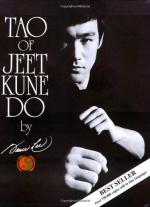
|
| Name: _________________________ | Period: ___________________ |
This test consists of 15 multiple choice questions and 5 short answer questions.
Multiple Choice Questions
1. According to Bruce Lee's teachings, what expression opens thought, feeling, and will to the world of nature?
(a) Technology.
(b) Math.
(c) Science.
(d) Art.
2. The straight rear thrust to body is a _____ used as a counter or after a preliminary feint.
(a) Kick.
(b) Trick.
(c) Power blow.
(d) Parry.
3. Lee explains that a dancer requires different warm up exercise _____ and _____ from an older martial arts fighter.
(a) Times/Types.
(b) Examples/Models.
(c) Sets/Repetitions.
(d) Sketches/Illustrations.
4. What moves a joint by becoming longer or shorter in order to cause motion that may be slow or fast?
(a) Streching.
(b) Muscles.
(c) Exercise.
(d) Tension.
5. What does the author recommend that includes alternate splits, running in place, high kicks, and deep knee bends?
(a) Boxing.
(b) Circuit training.
(c) Gymnastics.
(d) An eleven step fitness program.
6. Lee says the uppercut is used in close-quarters but it is useless with fast _____ that stand upright and jab.
(a) Boxers.
(b) Masters.
(c) Fencers.
(d) Wrestlers.
7. How many steps does Lee give for throwing one's opponent to the ground?
(a) Two.
(b) Seven.
(c) Eleven.
(d) Five.
8. What type of hook does Lee suggest for in-fighting when coming away on the break?
(a) Lead.
(b) Corkscrew.
(c) Shovel.
(d) Rear.
9. What example of moving and not moving does Lee use?
(a) A person driving in a car.
(b) A tree blowing in the wind.
(c) A moon seen under the waves.
(d) A jack-in-the-box toy.
10. Over the long history of martial arts, most systems promote forms and techniques that simulate _____ and can be practiced like a _____.
(a) Combat/Ritual.
(b) Peace/Meditation.
(c) Playfulness/Game.
(d) Tests/Rough draft.
11. Lee says that the main goal of Jeet Kune Do is kicking, hitting, and _____.
(a) Applying bodily force.
(b) Posture.
(c) Winning.
(d) Non-attachment.
12. Who is the main author of the book?
(a) Jeet Kune Do.
(b) Gilbert Johnson.
(c) Bruce Lee.
(d) Linda Lee.
13. A fighter's ability to _____, Lee says, creates openings for _____.
(a) Adapt/Change.
(b) Be free of thoughts/Enlightenment.
(c) Confuse/Attack.
(d) Fight/Winning.
14. What does Lee say there is no need for in Buddhism?
(a) Training.
(b) Stress.
(c) Change.
(d) Effort.
15. The author suggests that the lack of _____ lets things disclose themselves.
(a) Energy.
(b) Will power.
(c) Time.
(d) Self-rigidity.
Short Answer Questions
1. What does Lee refer to as the offensive and defensive weapon, which is the backbone of punching in Jeet Kune Do?
2. What does Lee believe is a primary need of the on-guard position?
3. What position does Lee consider to be the most favorable and underlies all recommended techniques and skills?
4. Which move does Lee say is effective as a counterblow, like a loose, snappy punch?
5. What does Lee describe as dangerous in attack or defense?
|
This section contains 451 words (approx. 2 pages at 300 words per page) |

|




